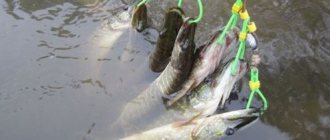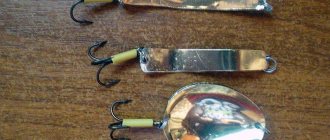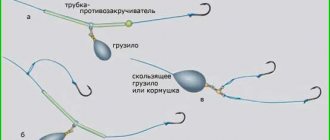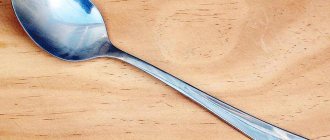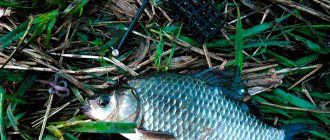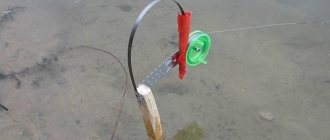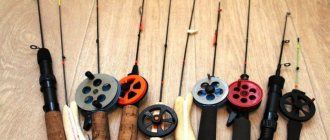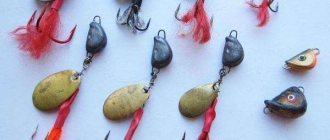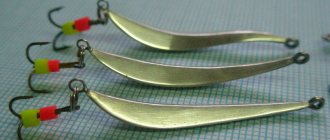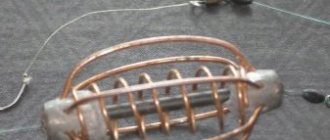Kukan Vinogradova
Making a Vinogradov's kukan with your own hands is also of interest to many fishermen, since this device is intended for underwater hunting. You will need to get a metal needle, which can be made from a tube with a diameter of about 10 millimeters. The tube must be cut at an angle and treated with sandpaper.
Now you will need to find a thick nylon cord or get a cable wrapped in braid. It is much easier to put fish on a line. Typically, the length of the cable is selected within one meter, depending on the number of fish caught. In addition to the cable, you also need to purchase glue and two nails. The tools are very simple, all you need is a file, a hammer and a vice.
Making Vinogradov’s kukan with your own hands is quite simple; you just need to adhere to certain recommendations and follow a clear sequence of actions:
- Take the cable and solder the ends of the insulation on a gas stove or with a lighter.
- The sealed ends need to be generously coated with glue so that they take a smooth shape and wait until completely dry.
- Now you need to take a needle and drill holes in it, one about 20 millimeters from the edge (which is not cut at an angle), the second 20 millimeters from it. The diameter of the holes depends on the thickness of the selected cable.
- Now you need to insert about 10 centimeters of the cable inside and hammer the nails into the holes. The sharp ends of the nails must be cut off.
- The second end of the cable must be formed into a loop and all burrs removed with a file.
How to make fish kukan with your own hands?
Fishing is one of the most popular hobbies. Today, for avid fishermen, stores sell all the necessary accessories: baits, sinkers, spinning rods, equipment, and so on. However, many users prefer not to buy some things, but to do it themselves. In this article we will learn how you can make your own kukan for fish.
Recommendations for the use of kukan
Using a homemade kukan is a very simple task, as is its manufacture. But not everyone knows how to store fish impaled on it. If certain rules are not followed, you can simply injure the caught fish and it will not live long.
Follow the recommendations provided to maximize the life of your catch and avoid injury to the fish:
- When fishing for pike, it often happens that it swallows the tee deeply and safe removal is simply impossible; most often this happens when the fish xxl bite activator is used while fishing. It is best to disconnect the hook from the bait and place the predator on the kukan along with it. So she will live about 4 hours.
- After hooking, the fish will still be active for several hours. When catching several trophy specimens, you should not put them on one tackle and drag them behind the boat while moving around the reservoir. It is better to secure the kukan away from the fishing spot so that the prey does not scare away other fish.
- Planting fish must be done very carefully. You need to be especially careful when mounting a pike, since in addition to teeth on its jaw, it also has small spines on its upper palate. If you don't watch your fingers, the fish may simply bite you, which is not very pleasant.
As you can see, building a fish kukan with your own hands is not such a difficult task, which will take no more than an hour of time. But, regardless of whether you bought the tackle or made it yourself, you need to adhere to the general recommendations for hooking and transporting fish.
DIY photo of kukan
Read here Do-it-yourself casting net: manufacturing stages, net diagrams and tips on how to catch fish with a casting net
Help the project, share on social networks
0
What is kukan
A fisherman who has caught a fish is faced with the question of how to deliver the caught fish fresh to his home. Fishing can last for many hours, during which time the fish will have time to spoil. The best way to preserve caught fish is to keep them alive in the aquatic environment. Kukan is one of the devices that allows you to do this.
When a fisherman catches fish, he needs to think about how to get it home fresh. Fishing can last for many hours. In this case, the fish caught at the beginning must be preserved throughout this time. An effective solution to this problem is to preserve the trophies alive in the aquatic environment. Kukan is a device that helps to do this.
Kukan is a special device for storing caught fish in water. Kukan allows you to keep fish alive for a long time and allows the fisherman to bring the caught fish home in fresh condition.
Kukan consists of a synthetic cord or metal cable with metal or plastic fasteners suspended on it for the caught fish. Fish fasteners are most often made from durable stainless wire. At the end of the cord or cable there is a carabiner or loop for securing the cucan. The end of the kukan is secured on the shore by a peg stuck into the bank or by a branch of a tree or bush growing on the shore.
The caught fish, after being removed from the hook, is transferred to the kukan. The fastener of the kukan is passed through the fish's mouth, then brought out under the gill cover, the fastener is snapped so that the fish does not break loose and escape.
When immersing a kukan with fish in water, you need to choose the right place for this. It is better to keep the kukan with fish in the shade, in a place with running, oxygenated water. It is advisable for the fish to be in the lower, deeper layer of water, then it will stay alive longer. To do this, a weight is tied to the lower end of the kukan.
When there are several fish on the kukan, it is better to keep it away from the fishing spot, otherwise the noise and fuss of the fish placed on the kukan will scare away the other fish around the fishing spot.
In autumn, in cool water, fish caught and placed on a kukan can remain alive for 1-2 days.
Kukan can be used for spinning fishing from a boat. The end of the kukan is tied to the oarlock. You need to tie the kukan on the side of the boat from which you will not be casting.
Kukan is convenient for spinning and fly fishing. In this case, the end of the kukan is tied to the branches of a bush on the shore or by a belt on the angler’s belt.
Kukan is used by underwater hunters; they most often attach the kukan to their belt.
Using kukan
To ensure that the caught fish is not injured and remains alive, it is secured with a cord or cable threaded through a slot in the lower jaw or gills, and then placed in the water.
Being in its natural environment, the fish remains viable and does not require preservation for a long time.
On the shore, the kukan is secured with stakes, and on a boat with a halyard.To prevent especially strong and large specimens from coming off, it is necessary to attach an additional wire clamp to the end of the needle.
A loop on the kukan cord will help you carry it on the angler’s waist belt.
Kukan for underwater fishing is fundamentally no different from the usual one, and you can also make it yourself. An integral part of the kukan for underwater hunting is a loop on the kukan cord, which allows it to be attached to a carabiner on the underwater hunter’s belt.
Note!
How to minimize fishing costs? Useful tips from experienced fishermen and an overview of current solutions (65 photos)Do-it-yourself boat motor - tips for beginners, projects, drawings and step-by-step description of the construction of the main components and elements (video + 120 photos)
Feeder for winter fishing - secrets of use and techniques for feeding fish in winter (115 photos)
Kukan for spearfishing
When a fisherman stocks up with devices for preserving fish: a kukan, a cage or others, he can calmly fish without worrying about the future fate of the fish. When spearfishing, there are much fewer opportunities. However, in this case, it is possible to use the kukan.
In order to explain why it is needed, it makes sense to imagine what will happen if an underwater hunter does not have such a device at his disposal. Having hit a fish with a harpoon, he will have to return to the shore with the prey, ensure its safety, and only then go hunting for the next fish again.
However, using a kukan eliminates this need. It allows you to keep your prey with you and continue hunting. Although it is not as important as a speargun, its use nevertheless makes the hunting process much more comfortable.
How to make kukan with your own hands:
There are two options for mounting this device. The first is the use of a buoy. It is located on the surface of the water nearby and all the caught fish are attached to it.
Another option is to attach it to your belt. This makes the hunter more independent. But at the same time it creates the need to constantly drag the caught fish along with you.
When using kukan, you need to remember that it cannot be used for bream, ide and some other fish. The fact is that their lip or gills can easily rupture, and the fish will fall off the hook and die. It is beneficial to use this device when hunting predatory fish: eel, pike, catfish and others. These fish stay firmly on the kukan.
This device consists of the following components:
- There is a mount that holds the kukan with fish.
- A stainless steel metal needle is used. It is needed to pierce the caught fish.
- A cable is used on which the prey is attached.
There are several designs of homemade kukans.
The simplest of them looks like this. Instead of a needle, a thin metal pin is used, to the middle of which a cord is tied. At the other end of the flexible element there is a loop with which the kukan is attached to the belt. After the fish is caught. The hunter pierces her with a metal part. He threads it all the way through and continues hunting. At the same time, the prey swims behind it, clinging to various objects.
Sometimes kukans are used in the form of a fine mesh. Its edges are made in such a way that it can be wrapped around the body and put prey in the net like in a pocket. This method is convenient in its own way, but it cannot be used if large and heavy fish are caught.
Modern kukans use braided wire as a flexible element. The needle is attached to one end, and the fish cannot slip off it because the design has a folding pin that prevents this. If the fish is too active, then it is enough to pierce the cerebellum with a needle so that it stops struggling.
A special fastener is used for attachment. It looks like this.
You can make a kukan for spearfishing with your own hands. First you need to make a needle. It is recommended to use stainless steel or aluminum as the material for manufacturing. To do this, it is convenient to use a tube no less than 12 and no more than 16 cm long. If such a part is not found at home, it is not difficult to find it in a car store. One side is filed with a file at an acute angle and carefully cleaned with sandpaper so that no burrs remain.
At the blunt end, two holes are drilled at a distance of 2 and 4 cm from the edge.
It is convenient to use a laundry cord as a flexible element, which is made in the form of a flexible metal cable located in a plastic sheath. After the desired piece is cut, the polyethylene is sealed at the ends. This can be done conveniently with a lighter.
The cable is inserted into the tube from the blunt end, and in the places where holes are made they are pierced with nails. The protruding ends are bitten off and the edges are flattened with a hammer. Then they are carefully cleaned with a file.
A loop for attaching to a belt can be made in this way. From the tube from which the needle is made. Cut a ring 4 mm thick, thread the cord 10 cm, then wrap it and thread it again into the ring, which must be flattened with a hammer.
To store the needle, you can use a rubber tube of a suitable size.
Making kukan for fishing
There are several options for preserving fish so that it does not spoil. The first solution is a cage, but this option is not convenient for boat fishing, because it is not easy to swim to a new place with it. The second solution is a kukan, which can be made from available materials.
What is kukan for fish?
Kukan
(translated from English Fish Stringer) is a device for storing and moving catch. After fishing for a large fish, it is placed on a kukan.
In simple terms, a kukan is a thick cord with a thick wire loop at the end.
How to bait a pike on a kukan
To mount a pike, you first need to hold it from above by the eye sockets, immerse your thumb and forefinger in them, and pierce both jaws of the fish from top to bottom with the rod of the kukan 2 times.
Kukan is a device that should be in every fisherman’s arsenal.
What you need to prepare for work
- a cable with a diameter of 2 or 3 mm of at least 5 m, most of it (5 parts of 0.7 m each) will be used for loops;
- cable clamps - 12 pieces;
- 2 large carabiners for the ends of the cable, and 7 smaller ones for the loops;
- plastic tubes 20 cm, 4 pieces;
- 5 swivels - small devices to avoid twisting.
You will also need wire cutters for cutting through metal, a tape measure and a hammer.
The process of making a kukan for pike
Cut the cable into 5 pieces of 70 cm each. There should be 1 long piece of 1.5 m. You need to put on it: a swivel, then a tube, then 4 devices to avoid twisting, and the final fifth closes the entire chain.
Attach large carabiners to the edges of the cable with clips. And put the small ones, 2 pieces each, on the free edges of the swivels.
Make loops from the remains of the cable and secure the edges with clamps. You can make a strong setting using a hammer. Attach the loops to the carabiners. The device is ready.
Kukan from a knitting needle
You can make a device from a knitting needle. To do this you will need:
- metal cable, chain or nylon cord;
- a bicycle spoke or an equally strong wire;
- plastic separator tubes;
- carbines;
- end sinker.
First, attach the weight fastening to the end of the main cord with a carabiner on the outermost link.
Place the tubes and carabiners on the lace in order. The tubes must be selected according to the diameter of the cord. If it is a chain, the carabiners are attached through a specific number of links. The length depends on the planned catch: for catfish - up to 20 cm, for pike or pike perch - 7 or 10 cm.
A loop is made at the upper end, the end of which is threaded into a carabiner and secured to the shore or vehicle.
Kukan with float
Kukan with a float is a device for storing and carrying the caught catch. A float is necessary to prevent the structure from accidentally sinking. If this happens, the device will be visible, and thanks to it you can easily remove the kukan from the water.
Homemade kukan
As noted earlier, the kukan is a wonderful device in terms of functionality, then let's try to make a kukan with our own hands at home. At the same time, quite often the fisherman manages to get a product with his own hands that is much more reliable than those offered in stores.
Design requirements
How to make a kukan, the use of which will be pleasant and convenient?
Regardless of the chosen type of form, a number of similar requirements are imposed on kukans, the observance of which is necessary:
- simplicity both in manufacture and in operation, because the latter is so necessary in difficult fishing conditions;
- it is necessary that the kukan can easily pierce the cartilaginous jaw of the fish, but not injure it at the point of grab;
- Considering that you are going to literally store a rather large catch, the device must withstand a large load - at least 20 kg, however, remain elastic and not deform after compression;
- Continuing the topic of loads, the main cable must withstand a breaking weight of at least 60-70 kg;
- it is also necessary to take into account the fact that one kukan serves as a place for storing several individuals, so the fasteners must be positioned so that the fish can be near each other freely and not cause harm; It is recommended not to mount more than 5 fasteners if the kukan will be used on shore and no more than 20 on a boat fixture.
Accessories and tools
You can make a homemade kukan with the following materials at your disposal:
- braided cable with a diameter of 2-3 mm; for the main manufacturing method, you will need at least 5 meters of cable, while most of it (5 pieces of 70 cm each) will be used for loops;
- cable clamps, 12 of them will be required;
- there are 2 large carabiners for the ends of the cable, and 7 smaller ones for the loops;
- 20 cm long plastic tubes, 4 pieces;
- 5 swivel.
The tools you will need are metal cutters, a tape measure, and a hammer.
Master Class
Let's move on to how to make kukan with your own hands. 5 meters of the cable must be cut. As mentioned earlier, you will need 5 pieces of 70 cm, after which there will be 1 long piece of 1.5 meters.
Swivels and plastic tubes are strung on this long cable, and the order is as follows: the swivel goes first, then the tube, after 4 swivels and tubes have been put on, the last swivel closes the chain.
We attach large carabiners to the edges of the cable using clamps. We put small carabiners (2 pieces each) on the free edges of the swivels.
From the remaining parts of the cable it is necessary to make loops, the edges of which are fixed with clamps. Use a hammer to get a tight seal. The loops are attached to carabiners, after which you can use the kukan for its intended purpose.
Manufacturing
If all the necessary components and devices are prepared, you can proceed directly to making the kukan. If you have not encountered such work before, then it makes sense to rely on detailed step-by-step instructions for creating the fishing accessory in question.
- First you need to divide the cable of a suitable length into 6 separate sections. One of them should have a length of 1.5 m. This segment will correspond to the length parameter of the kukan itself. The remaining 5 segments, each 0.7 m long, must be left for further production of loops.
- You need to take a cable, the length of which is 1.5 m. You will need to carefully put plastic or rubber tubes on it, depending on which one you have chosen for the work.
- Next, you will need to properly secure large carabiners at the ends of the cable section. This can be done using special clamps.
- You should still have small carabiners. They will need to be installed on swivels.
- From 5 cut pieces of cable, each 0.7 m long, you will need to build strong loops. It is these components that will be responsible for the reliable retention of fish caught in the reservoir. The hinges will definitely need to be secured using reliable clamps. To make the final and most powerful clamp, you should use a hammer.
- Do-it-yourself strong and securely installed loops will need to be attached to carabiners. The latter will need to be pre-installed on the main cable.
Once collected in this simplest way, you can safely use the kukan and go fishing with it. This homemade device is suitable for catching a wide variety of fish. Thus, many fishermen make kukan for catfish, carp, pike, pike perch, asp and other types of fish.
The described method of making kukan yourself is not the only one. Different fishermen use different methods. For example, it is more convenient for someone to knit this device from soft rope, knitting needles and other available materials.
Varieties
Let us list the main types of kukan designs.
- The simplest kukan is based on a thin metal cord, to one side of which a short knitting needle is attached, and a loop is made from the other end; it is the latter that is inserted under the gills, after which it is tightened on a knitting needle;
- A nylon cord can be used as a base, onto which wire loops are placed, in which case we can talk about a wire-thread kukan; Such products must be dried after each use, and the downside is the possibility of the fish biting the cord and leaving the fisherman, right with the hook attached;
- A triangular kukan is made from a long metal knitting needle, which is bent to give it a triangular shape; after bending, fasteners are threaded onto the knitting needle, and the top can either be soldered or wrapped in the manner of a fastener; the advantage of this option is the possibility of greater immersion of caught fish, which leads to longer storage;
- Round-shaped kukans are rings onto which previously bent steel hook-and-loop clasps are placed; the ring is sealed, and the kukan can be secured using a rope or a thin chain;
- Kukan can also be one large metal clasp; it is made from fairly thick (3-4 mm) steel wire, which is bent to form a U shape; then one edge is bent at a right angle, and on the other a loop is made, at the end of which there is a hook that acts as a fastener.
Kukan designs
A small knitting needle is attached to one end of the metal cable, and a loop is made from the opposite end of the cable. The loop is pulled under the gills and secured with a knitting needle.
Wire loops are attached to the nylon cord. Such a kukan requires mandatory drying after it gets wet. The disadvantage of this design is the possibility of fish biting the nylon cord.
The metal knitting needle is bent in the shape of a triangle and fasteners are put on it. The top is sealed or folded into a clasp. This design allows you to store fish at a significant depth, which increases its shelf life.
Kukans in the form of rings. Metal clasps with loops and hooks fit onto the ring, which is sealed. The kukan is fixed with a cord or a small chain.
Kukan in the form of a fastener is made of steel wire about 3.5 mm thick. The wire is bent in the shape of a U sign. One end is bent at an angle of 90 degrees, and the opposite end is bent in the form of a loop. The resulting structure serves as a fastener.
What tools are needed to make kukan?
It is difficult to recommend any specific tools, because each person may prefer to use different tools to create kukan. But here is a list of the tools that you will obviously need:
- Wire cutters. Needed for cutting cable or wire.
- Chisel. Also serves to cut the cable (when it is large in diameter).
- Roulette. In order for the kukan to turn out to be of really high quality, it is advisable to maintain certain dimensions; this is exactly what this tool will be needed for.
- Pliers. Required for fastening clamps on hinges.
- Hammer. Will be needed throughout the entire manufacturing procedure.
How to make kukan?
Step 1. First of all, take a reliable cable 6 meters long and with a diameter of 0.3 - 0.5 mm. Next, it is cut into pieces, the largest of which will serve as the basis of the tackle (2 meters). And from the remaining 8 parts loops will be made (each 50 cm). Step 2. Previously prepared swivels and tubes are put on the main cable
It is important that their diameter is slightly larger than the diameter of the cable. They must alternate in the correct order: first the swivel is put on, and then the tube
Thus, the tackle will require 8 swivels and 7 tubes. Step 3: Once the swivels and tubes are in place, loops are made at both ends of the cable using aluminum clips and large carabiners are placed on them. Thanks to two large carabiners, the kukan clings to the place the fisherman needs. Step 4. Preparing the loops will not take much time. You will need to make 8 loops, using a hammer and clamps to secure them tightly. The fish will subsequently be threaded onto the loops. Step 5. 8 small carabiners are attached to the previously prepared swivels, and loops are already put on them. This way, taking off and putting on the fish will be convenient and easy.
As you can see, the procedure for creating a kukan with your own hands is not so complicated. The only thing you need is the necessary parts, tools and a little ingenuity.
When making, you can use completely different sizes, based on how much fish you plan to catch, what size this fish will be, etc.
Also, instead of loops, homemade hooks made from strong wire or a bicycle spoke can be used. The knitting needle is bent into a horseshoe shape. After this, a small loop is made almost at the very end of the knitting needle, and the end itself is bent so as to form a hook. The second end is bent at 45°. Ultimately, we get a hook with a loop, as well as an opening and closing mechanism. Using a loop, it is attached to the swivel, and after the fish is put on it, it is closed using a created mechanism so that the fish does not come off. Considering that the knitting needle is very rigid and durable, the fish is unlikely to be able to escape from such a hook. Very suitable for storing pike.
Making Vinogradov's kukan with your own hands
In most cases, this type of gear is used for underwater fishing, but some anglers also use it for regular fishing from the shore. So, to make Vinogradov’s kukan with our own hands, we will need the following parts:
- a homemade metal needle; a small-diameter metal tube is suitable for its manufacture (by cutting it at a slight angle and processing it, you will get a pointed end);
- a strong rope of small diameter, preferably in a plastic sheath, its length should be adjusted to the number of fish (from 1 meter);
- carbine.
Manufacturing process
- Take a rope and use a lighter to singe its ends.
- At one of the soldered ends, a loop is tied for a carabiner.
- Using a drill, drill a hole in the needle: preferably at a distance of two-thirds from the pointed end of the tube.
- Use a small file to remove all sharp edges of the hole so that the cable does not fray. The cable is threaded through a prepared needle and tied into a loop.
- The ends of the cable are melted using a lighter.
The result is a finished kukan. A needle is used to pierce the lower jaw of the fish and push it onto the cable itself. When the fisherman releases the needle, it turns perpendicular to the puncture and prevents the fish from leaving. In this way, you can place up to 10 fish on Vinogradov’s kukan.
In general, this kukan is easier and faster to make than a standard one; you will need literally a couple of hours of time and little expense.
